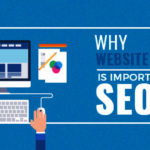Technology is constantly changing and businesses have been constantly evolving to take in these changes. From traffic to content, conversion rates and branding, there are many aspects of a website’s design that affects the presence of the business on the Internet.
Two perspectives
It is a true fact that very few business owners realize the importance of building a well-designed website. Many business owners, big and small see the entire effort as more of a chore.
What they fail to realize is that a website is a fully separate channel that will bring in the leads for your organization. What is better is that it takes less effort to set up a well-designed website than train an entire sales team.
On the other end of the spectrum are those entrepreneurs that invest thousands or even millions of dollars on website design/redesign. Web design, though important from the aesthetic point of view, is much more than just being attractive.
This article chooses to explore why web design matters at all and what impacts it has on different aspects of an online business.
1. Trustworthiness and basic design elements
In some of the studies that were conducted one startling fact that was revealed was that respondents labelled a website as being trustworthy or otherwise more on the basis of the design elements present than its content.
The ratio was 94:6.
Websites that have small prints, those that displayed pop-up ads, complex website layout, all contributed to mistrust from the respondents.
Another aspect that was revealed was that whereas some colours were good when used for specific businesses, it would not suit certain others.
In case the business already has a logo or a colour scheme, it pays to use the same on the website for easy recognition and relatability.
Use of similar colours and similar fonts as the logo is important. Use highlighted text sparingly. Go for a simpler logo than a complex one if you are designing a new one.
2. Navigation should be easy and consistent
Site-wide navigation that is the same on every page is appealing for a website. Your visitors should know at any point in time as to where to start.
Display of a search box in direct view of the user always is recommended. If your website ends up challenging the visitors, there is a high chance that they will lose interest and quit browsing further.
Avoid displays that clutter up and provide the visitor with information without any interruptions.
3. Faster websites sell more
The speed with which a website loads is an important factor in satisfying the customer. Almost half the respondents in a survey said that they expected that the website would load in about 2 seconds’ time.
Any additional delay of a second in the loading time of a website is costly for the business and there is also a substantial reduction in the customer satisfaction.
It is important to give that experience to the customer which they will be happy to remember. If your website’s loading speed is good, they are likely to talk about it to their peers.
4. Make the Call-to-Action visible
Place the call-to-action button on every page of the website. Ensure that it is visible and the visitor does not have to scroll down to see it. More importantly, add a benefit to the call-to-action.
That is more than likely to get you more conversions. One research showed that use of the word ‘free’ along with the call-to-action button increased conversions by about 4.2 percent.
Other phrases which were seen as appealing ones included, “Buy now”, “Start the two-week trial”, etc., among others.
5. Make video stories
Include storytelling videos on your website. Studies have indicated that videos dramatically increase conversions in websites.
Great video ideas include those that tell the visitor what is happening behind the scene video that shows how your product is created and what work has gone into it, product tours and case studies about a specific problem that a customer encountered, the solution and the end result accompanied by a simple attractive script.
Testimonial videos are known to do their bit for your website. Allow people to announce how happy they are after using your product or service.
6. Improve the trust by displaying badges
Incorporate badges as part of your website. It is indeed a design element that can bring in more trust from your website visitors. They can be categorized into:
- Trust badges: Procure and display trust badges from review sites. TripAdvisor and Trustpilot are popular badges.
- Security badges: Companies such a McAfee show to the visitors that the link to your website is encrypted and allows for safe transactions to be sent through the website’s landing page by the visitor.
- Award badges: Display industry’s best awards if you have any. Do not fail to announce the awards, if any have been won by the designers and developers of your website.
7. No distractions, please
To increase conversions, it should be easy for the customers to make decisions. Do not make the website journey a confusing one for our visitors. Offers, pop-ups and too much of movement are likely to confuse the visitor.
Too many offers will end up becoming counterproductive. When there are too many, the visitor will be confused as to which one to pick.
The website visitor has to be safely guided through the sales funnel and get them to make a purchase. The golden rule is to keep distractions to a minimum.
8. Website-SEO relationship is important
SEO is a good method to make your website more visible to the search engines and customers at large. Getting a top slot in the search engine listings gets you your prospective customers’ attention.
This translated to a higher amount of traffic and consequently more conversions. The first step of SEO is good website design. With a great website design, you have already announced your arrival.
The rule of the thumb is do not neglect traditional website design structures that search engines look for while crawling in favour of modern trends. Have a healthy mix of the two.
9. Become Mobile Friendly
Most buying decisions of today are made with the mobile. With most people using the web on mobile phones and tablets, you can lose out if your business website is not optimized for a mobile device.
If you want your website to be seen on a computer as well as a mobile device, then you should have only very little media that is attached to the website design.
This may not work out the way you want all the time. However, it is better to have a mobile-optimized version of your business website. The website should contain all the relevant information that the customer needs to see.
10. Keep your website design contemporary
The bounce rates are going t be higher if you have an outdated website design. Old-fashioned websites are likely to be a turn-off. If they feel that you are not up-to-date, in either your content or design, they are going to bounce off your pages.
It is a good idea to review your website once in a couple of years or every year and freshen it up to reflect the latest trends.
11. Content is still king
While website design is important, content is still the king. Websites that presented lucid, no-nonsense and unbiased information were liked by most users. Other popular designs included FAQ’s and sites giving information to specific age groups.
12. Website design is one of the most important of your brand elements
The design of a website does not equate to your brand. However, website design by itself is an important brand element that helps your customer to place trust in you.
Branding is that invisible factor, or a perception, that grows over time and gets your client to trust your product/service no matter what. Other brand elements can be logos, taglines, packaging, trademarks etc.
The dozen points discussed above are basic ideas that can get your web design on track and make a difference to your customers. How your website looks and functions are key factors that would influence the outcomes of your business decisions.







